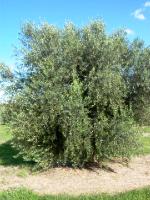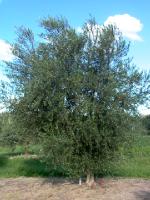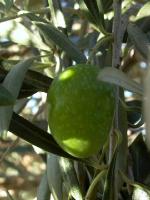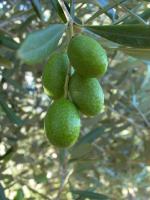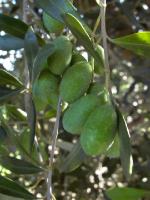Olive Varieties
Australis Plants can supply the following listed varieties. Most photos of the olive trees listed have been taken from one of our motherstock areas in QLD. All of our olives trees are propagated from mature trees of bearing age to ensure the earliest possible start bearing in the nursery stock supplied. Trees are available all year but forward ordering is recommended.
Please contact our office or see the stocklist for our currently available stock.
Although Australis Plants can provide you with useful information regarding varietal selection for your area, we also recommend that you undertake you own local research to determine:
- The varieties that are performing best in your area and,
- Which varieties are preferred by the processor/market you intend to supply.
Variety Descriptions
A | B | C | D | E | F | G | H | I | J | K | L | M | N | O | P | Q | R | S | T | U | V | W | X | Y | Z
Click on the links to view images of plants.
Small fruit (1-2g). Bears young. High yields. Ripens early/mid season. High oil content. Origin: Spain. Considered cold resistant.
Performs well in warm and cold climates. Ornamental tree suitable for pots, hedges, etc. Suitable for intensive cultivation. Self-fertile.
Small/medium fruit (2-3g). Early start to bearing. High yields. Ripens early/mid season. Medium oil content. Origin: Unknown.
Low chill requirement. Showing promise in warm winter climates.
Large table fruit (4-12g). Medium yields. Ripens mid/late season. Pickled green or black. Origin: Chile.
Named after the valley in which it grows, close to the Peruvian border. Chile's most important table fruit. May be related to Sevillano.
Medium fruit. Bears young. High yields. Medium to high oil content. Ripens mid season. Can be pickled.
Origin: Israel. Suggested cross-pollinators are Picual, Manzanillo, Picholine.
Also known as Uovo di Piccione. Large table fruit (~7g).Suits warm to cold climates. Cold tolerant. Medium yields. Ripens mid/ late season.
Usually pickled green. Origin: Tunisia. Small spreading tree suited for hand picking.
Small / medium fruit (2-3g). High yields. Ripens late season. High oil content. Origin: Tuscany, Italy.
Suggested cross-pollinators are Leccino, Coratina, Pendulino.
Medium fruit (2-3.5g). Bears young. High oil content. Ripens late season. Origin: Apulia, Italy.
Considered dual purpose. Very cold resistant. Usually pickled green.
Cucco
pic1
pic1
Medium / large fruit. Ripens early/mid season. Usually pickled green. Origin: Italy. Cold Tolerant.
Suggested cross-pollinators are Frantoio, Leccino, Coratina and Pendulino.
Small/medium fruit (3-4g). Early start to bearing. High yields. Ripens mid season. Medium oil content.
Origin: Unknown. Low chill requirement. Showing promise in warm winter climates.
Dr Fiasci
Small / medium fruit (2-3g). High yields. Ripens mid/late season. High oil content. Pickled fruit have a nutty flavour.
Can be processed as Ligurian olives. Origin: Tuscany, Italy. Compatible pollinator for a range of varieties.
Suggested cross-pollinators are Leccino, Coratina and Pendulino.
Hardy's Mammoth
Large fruit. Slow start to bearing- up to 7 years. Mainly used as table fruit. Pickled green or black. Oil quality high.
Medium oil content. Origin: Unknown. Suggested cross-pollinators unknown.
Very similar to Frantoio, Origin:unknown - Collected from old penal settlement on St Helena island in Moreton Bay, QLD.
Medium sized fruit (2-4g). Dual purpose. High yields. Pickled green or californian black style. Low oil content but high quality oil.
Ripens late season. Origin: Spain. Suggested cross-pollinators are Arbequina, Manzanillo and Picual.
I-77
pic1
pic1
Medium fruit (5.2g).High yields. Ripens Early/Mid season. High oil content. Early start to bearing.
Origin: Italy (Olive Oil Research Institute, Perugia). Low vigour variety (semi dwarf) selected for intensive plantings.
Very large table fruit (~12g) with a small seed. Impressive fruit size but flesh can be tough and fibrous if
not processed correctly. Not related to the true Kalamata variety. Usually pickled green. Origin is unknown but the fruit is similar in form to the Italian variety Oliva di Cerignola.
Medium/ large fruit (3-5g.) Dual purpose. Medium/high oil content. Good quality oil. Pickled black. Origin: Greece. Highly regarded fruit for processing.
Suggested cross-pollinators are Coratina, Frantoio and Koroneiki. Trees are grafted
Large fruit (6-8g.) Large Table Fruit. Pickled black. Origin: Greece. Kolossus is similar to the true Kalamata but the fruit is up to double the size and the tree is more cold tolerant. Highly regarded fruit for processing.
Suggested cross-pollinators are Coratina, Frantoio and Koroneiki.
Small fruit (1-2g). Bears young. High yields. High oil content. High quality oil. Ripens mid/late season. Origin: Greece.
Performs well in warm climates. Suitable for intensive cultivation.
Leccino
Small /medium fruit (2-2.5g). Bears young. Med /high oil content. Ripens early/mid season. Origin: Tuscany, Italy. Considered dual purpose. Very cold resistant.
Suggested cross-pollinators are Frantoio, Coratina and Pendulino.
Medium / large fruit (4.8g). High yields. Ripens early. Excellent pickling fruit. Pickled green or black. Fruit is of excellent taste and texture.
Fruit should be processed before it is fully ripe to retain flesh firmness. Origin:Spain. Not recommended for oil, as oil extraction can be difficult.
Suggested cross-pollinators are Sevillano, Frantoio, Picual and Arbequina.
Nab Tamri
Very Large fruit (10-11g). Moderate yields. Pickled both green and black. Origin: North Africa.
Medium sized fruit (2-4g). Dual purpose. High oil content. Ripens early/mid season. Origin: Spain. Very poor fruit set in some areas.
Suggested cross-pollinators are Arbequina, Manzanillo and Picual. Unreliable bearing habit but makes a good ornamental tree.
Oblitza
Medium sized fruit (5g). Medium yield. High oil content. Ripens early/mid season. Origin: Yugoslavia (Adriatic Coast). Cold tolerant.
Pickled both green and black.
Pendulino
Small sized fruit (1.6g). Medium yield. Medium oil content. High quality oil. Ripens early/mid season.
Origin: Italy. Cold tolerant. Main use is as a pollinator for Frantoio, Moraiolo and Leccino
Medium sized fruit (3.5-4.5g). Table/dual purpose. Medium/high yield. Medium oil content. High quality oil. Ripens mid/late season. Best pickled green.
Origin: France. Cold tolerant. Used as a pollinator for Barnea in Israel. Suggested cross-pollinators are Barnea and Picual.
Medium sized fruit (3-4g). Early start to bearing. High yields. High oil content. Ripens Mid/late season. Cold Tolerant.
Origin: Spain. Picual is largely self- fertile but can benefit from cross-pollination. Suggested cross-pollinators are Arbequina and
Hojiblanca. Picual is used as a pollinator for Barnea.
Large table fruit (9-11g). Medium yields. Ripens early/mid season. Usually pickled green.
Origin: Spain. Very cold resistant. Suggested cross-pollinators are Manzanillo and Arbequina.
Souri
Small/Medium (2.5-3.5g). Medium yields. Ripens late season. High oil content. Origin: Middle East.
Can be pickled. Regarded as one of the oldest varieties in the world.
South Australian Verdale
pic1
pic1
Large table fruit (5-8g). Medium yields. Usually pickled green. Origin: France - Australian selection. Cold resistant. Large seed but good flavor and excellent texture.
Swan Hill Fruitless
Used as an ornamental tree. Origin: Australia.
Produces mainly staminate flowers and sets very little fruit. Has shown resistance to Verticillum Wilt- making it useful as a rootstock.
Very large table fruit (~11.5g). Medium yields. Ripens early/mid season. Pickled green or black. Origin: USA.
Volos
Also Known as Konservolia. Large dual purpose fruit. High oil content. Ripens mid/late season.
Mainly pickled green but it also produces a good quality black-ripe olive. Origin: Greece. Very cold resistant. Trees are grafted.
Wallace
Large Table fruit.
Known in Australia as "White' it is belived to be the italian variety Biancolilla. ( Bianco meaning white in Italian) Medium dual purpose fruit 3-5g. Medium/high oil content. Ripens mid season.
The fruit is a light colour sometimes very white when green but as it ripens it turns purple/ black similar to most olives. It produces a light coloured award winning oil.
Origin: Italy. The trees are cold tolerant but fruit well in warmer climates. It and produces a medium size fruit thatcan be pickled green or black.
Wild Rootstock
Hardy rootstock that can be used for grafting Kalamata and Volos.


















